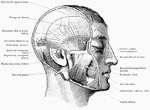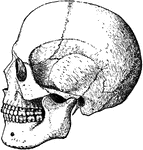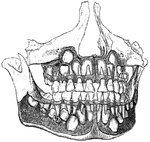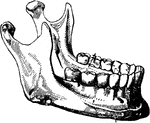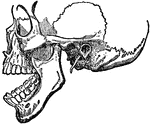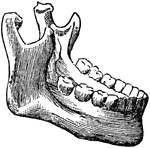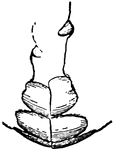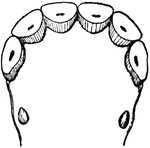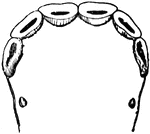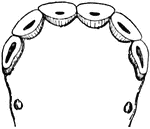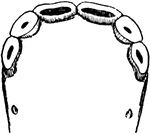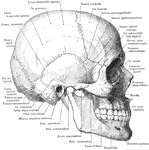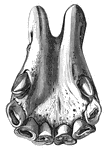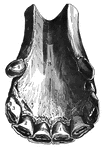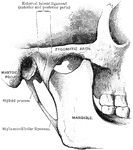
Back view of the adult mouth
"The head is represented as having been thrown back, and the tongue drawn forward. A, B…

Bennett's Kangaroo
"Skull and teeth of Bennett's Kangaroo (Macropus bennettii). i1, i2, i3, first second and third upper…

Fifth Cranial Nerve
The fifth cranial nerve. Labels: 1, orbit; 2, antrum of Highmore; 3, tongue; 4, lower jaw; 5, Casserian…
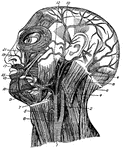
Facial Muscles
Muscles of the face, jaw and neck. 1, longus colli; 2, rapezius; 3, sterno-hyoid; 4, sterno-mastoid;…

Skull of a Common Fowl
"Fig. 62 Skull of common fowl, enlarged. from nature by Dr. R.W. Shufeldt, U.S.A. The names of bones…

Gray's Rat Kangaroo
"Skull and teeth of Gray's Rat Kangaroo (Bellongia grayii). c, upper canine tooth. i1, i2, i3, first,…

Head Showing Deep Mastication Muscles
A deep view of the muscles of mastication. The zygoma and masseter muscle are removed.
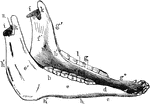
Inferior Maxilla of a Horse
Inferior maxilla of a horse-anterolateral view. Labels: a, body; b, b', rami; c, neck; d, mental foramen;…

Jaw at Birth
The lower jaw at birth. A, As seen from above. B, As seen from outer side. C, As seen from inner side.…

Jaw Showing Roots of Teeth
Horizontal section through both the upper and lower jaws to show the roots of the teeth. The sections…
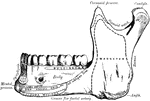
Mandible
The mandible is the largest and strongest bone of the face. It serves for the reception of the lower…
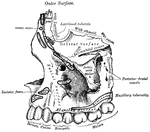
Maxilla
The largest bones of the face, excepting the mandible, and form, by their union, the whole of the upper…
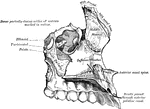
Maxilla
The largest bones of the face, excepting the mandible, and form, by their union, the whole of the upper…
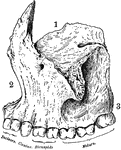
Human Maxillary (Upper Jaw) Bone
Superior maxillary bone. With it's fellow on the opposite side, it forms the whole of the upper jaw.…

Human Maxillary (Upper Jaw) Bone
Inferior Maxillary Bone (lower jaw). It is the largest and strongest bone in the face and serves for…
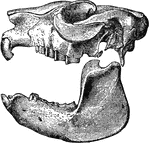
Mesotherium Cristatum
"Cranium and lower jaw of Mesotherium Cristatum." —The Encyclopedia Britannica, 1903

Nasal and throat passageways
"Diagram of a Sectional View of Nasal and Throat Passageways. C, nasal cavities; T,…
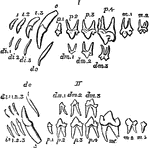
Permanent Dentition
"Milkand permanent dentition of upper (I) and lower (II) jaw of the dog, with the symbols by which the…
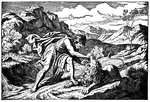
Samson Tears a Lion Apart with His Bare Hands
"Then went Samson down, and his father and his mother, to Timnah, and came to the vineyards of Timnah:…
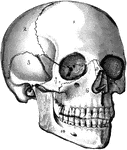
The Skull
The human skull. Labels: 1, frontal lobe; 2, parietal lobe; 3, temporal lobe; 4, the sphenoid bone;…
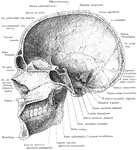
Median Section of the Skull and Mandible
Median section of the skull and mandible, viewed from the left.
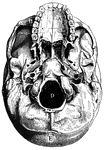
Base of skull
"A, Palate process of upper jawbone; B, zygoma, forming zygomatic arch; C, condyle, for forming articulation…
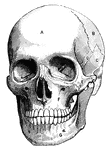
Human skull
"A, frontal bone; B, parietal bone; C, temporal bone; D, sphenoid bone; E, malar bone; F, upper jawbone;…

The Lower Jaw of a Squirrel
The backward and forward movement of the jaws and the great size and strength of the lower jaw, adapt…

Teeth
To show the relation of the upper to the lower teeth when the mouth is closed. The manner in which a…
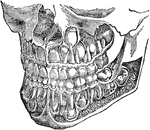
The Deciduous and Permanent Teeth
The deciduous and permanent teeth, shown as they are placed in the jaw with portions of bone removed…
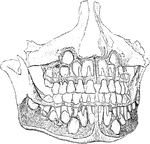
Development of Permanent Teeth
Well formed jaws, from which the alveolar plate has been removed to expose the developing permanent…
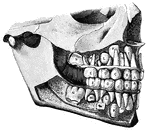
Temporary and permanent teeth
"Temporary Teeth: A, central incisors; B, lateral incisors; C, canines;…
